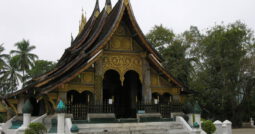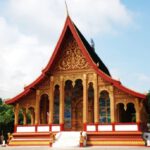Town of Luang Prabang
Luang Prabang is an outstanding example of the fusion of traditional architecture and Lao urban structures with those built by the European colonial authorities in the 19th and 20th centuries. Its unique, remarkably well-preserved townscape illustrates a key stage in the blending of these two distinct cultural traditions. Brief synthesis Luang Prabang is located in […]
Brief synthesis
Luang Prabang is located in northern Laos at the heart of a mountainous region. The town is built on a peninsula formed by the Mekong and the Nam Khan River. Mountain ranges (in particular the PhouThao and PhouNang mountains) encircle the city in lush greenery.
Many legends are associated with the creation of the city, including one that recounts that Buddha would have smiled when he rested there during his travels, prophesying that it would one day be the site of a rich and powerful city. Known as Muang Sua, then Xieng Thong, from the 14th to the 16th century the town became the capital of the powerful kingdom of Lane Xang (Kingdom of a Million Elephants), whose wealth and influence were related to its strategic location on the Silk Route. The city was also the centre of Buddhism in the region. Luang Prabang takes its name from a statue of Buddha, the Prabang, offered by Cambodia.
After the establishment of the French Protectorate in 1893, following a period of turmoil during which the country was divided into three independent kingdoms, Luang Prabang once again became the royal and religious capital during the reign of King Sisavang Vong. It played this role until Vientiane became the administrative capital in 1946.
Luang Prabang is exceptional for both its rich architectural and artistic heritage that reflects the fusion of Lao traditional urban architecture with that of the colonial era. Its remarkably well-preserved townscape reflects the alliance of these two distinct cultural traditions.
The political and religious centre of Luang Prabang is the peninsula, with its royal and noble residences and religious foundations. The traditional urban fabric of the old villages, each with its temple, was preserved by later constructions. The colonial urban morphology, including the network of streets, overlapped harmoniously with the previous model. Formerly the town limits were defined by defensive walls.
The richness of Luang Prabang architecture reflects the mix of styles and materials. The majority of the buildings are, following tradition, wooden structures. Only the temples are in stone, whereas one- or two-storey brick houses characterize the colonial element of the town. The many pagodas or “Vat” in Luang Prabang, which are among the most sophisticated Buddhist temples in Southeast Asia, are richly decorated (sculptures, engravings, paintings, gilding and furniture pieces). Wat Xieng Thong, which dates from the 16th century, comprises an ensemble of the most complex structures of all the pagodas of the town. It is remarkable both from the archaeological point of view, and from the Lao iconographic and aesthetic viewpoint. Many traditional Lao houses remain; they are built of wood using traditional techniques and materials introduced in the colonial period, such as plaited bamboo panels coated with wattle and daub. Brick colonial buildings, often with balconies and other decorative features in wood, line the main street and the Mekong. The built heritage of Luang Prabang is in perfect harmony in the natural environment. The sacred Mount Phousi stands at the heart of the historic town built on a peninsula delimited by the Mekong and the Nam Khan, domain of the mythical naga. Ceremonies to appease the nagas and other evil spirits, and Buddhist religious practices (Prabang procession, the monks’ morning quest) perpetuate the sanctity of the place. Natural spaces located in the heart of the city and along the riverbanks, and wetlands (a complex network of ponds used for fish farming and vegetable growing) complement this preserved natural environment.
Criterion (ii): Luang Prabang reflects the exceptional fusion of Lao traditional architecture and 19th and 20th century European colonial style buildings.
Criterion (iv): Luang Prabang is an outstanding example of an architectural ensemble built over the centuries combining sophisticated architecture of religious buildings, vernacular constructions and colonial buildings.
Criterion (v): The unique townscape of Luang Prabang is remarkably well preserved, illustrating a key stage in the blending of two distinct cultural traditions.
Integrity
The integrity of the inscribed site is linked to an architectural and cultural heritage set in a natural landscape that reflects its Outstanding Universal Value. All of the significant elements, especially the urban fabric and major monuments (temples, public buildings, traditional houses), have been preserved. However, there are some threats to the site due to the rapid development of the town and strong economic pressures, many of which are related to tourism (transformation of use of buildings, departure of residents, illegal construction).

Authenticity
The landscapes and urban fabric retain a high degree of authenticity, and the site is not disturbed by any major construction. The religious buildings are regularly maintained; monks teach young monks restoration techniques for their heritage. Moreover, the Buddhist cult and the cultural traditions related to it (rites and ceremonies) are still alive and practiced diligently. However, the degree of the authenticity of materials and construction techniques of many houses is low, since, for a long period, unsuitable modern techniques and materials (concrete, in particular) have often been used to replace traditional materials.
Protection and management requirements
The protection of the monuments and religious buildings of Luang Prabang is ensured by Decree No. 1375: 1978 of the Ministry of National Education and Sports, under the responsibility of the national and provincial administrations of the Lao Buddhist Federation. Decree No. 139, 1990, of the Ministry of Information and Culture assigns responsibility for heritage protection to this Ministry (at national level), to the Information and Culture Service (regional level) and to the district (local level). Article 16 of the Law on Environmental Protection No 09/NA, 1999, focuses on the historical, cultural and natural heritage; Article 7 deals with the obligation to conduct a socio-environmental impact analysis before undertaking any development and infrastructure project. Law No. 08 / NA on the national heritage, enacted in 2005, reinforces this legal arsenal. The authorities have developed the tools necessary to manage the property: Law on urban heritage protection, establishment of decentralized cooperation with the French town of Chinon, creation of a Luang Prabang World Heritage Department and establishment of National and Local Heritage Committees. The Safeguarding and Enhancement Plan (SEP) of the city consists both of a regulatory component having the force of law and a more adaptable component regarding recommendations to support projects while leaving some flexibility The religious authorities are particularly sensitive to the value of their heritage, with the support of the population. To counter the negative effects of rapid urban development, the regulations of the SEP include measures that the Department of Heritage must apply under the responsibility of the Local Heritage Committee and the National Committee. To respond to the new challenges (sustainable tourism, preservation of landscapes and surrounding agricultural areas), a wide buffer zone of 12,500 ha has been defined in the context of the revision of the Urban Plan that was approved by decree of the Prime Minister in February 2012. Large projects (new town, big hotels) are deferred until their impact can be assessed in regard to the Plan. In addition, public buildings (primary school, Fine Arts School) will not be conceded to the private sector, but they will be restored and will retain their cultural vocation. The Heritage House was restructured to become the Heritage Department in 2009. The new Heritage Department ensures strict application of the SEP and Urban Plan. Its mission is also to coordinate the actions of the Local Committee, raise awareness of the universal values of the heritage of Luang Prabang and advise those involved in development and infrastructure projects. Measures related to the use of traditional materials and techniques (wood, brick, tile and local ceramic) will be strengthened in order to preserve the integrity of the built heritage and local building traditions.
——————————
Lao People’s Democratic Republic
Province of Luang Prabang
N19 53 20.004 E102 7 59.988
Date of Inscription: 1995
Minor boundary modification inscribed year: 2013
Criteria: (ii)(iv)(v)
Property : 820 ha
Buffer zone: 12,560 ha
Ref: 479bis




